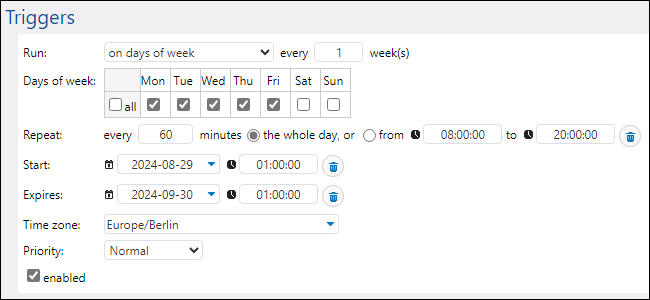Timers
Timers enable you to schedule jobs to start at a specific time and run for a specific time interval. Timers have flexible recurring options: e.g., they can be set to run daily, weekly, on specific days of the week or month. The screenshot below illustrates a sample timer.

The parameters of a timer are described below.
Property | Description |
|---|---|
Run | Defines whether the timer should fire once or every N number of days. The following options are available: Once, daily, on days of week, on days of months, on days in weeks of months.
|
Repeat | Defines how often the job should be fired within a particular period of time. The Every field defines the frequency of job execution in minutes (e.g., the job can be fired every 60 minutes). The from and to fields define the period during which the job will be fired (e.g., it can be fired every 60 minutes from 8 am until 8 pm).
|
Start | Defines the trigger's start date and time. When you click in the date field, a pop-up calendar opens, which allows you to select the start date. You can also type in the date manually.
The value of the Time field must be in HH:MM:SS or HH:MM format.
|
Expires | Defines the date and time when the trigger expires. When you click in the date field, a pop-up calendar opens, which allows you to select the expiry date. You can also type in the date manually.
The value of the Time field must be in HH:MM:SS or HH:MM format.
|
Time zone | Defines the time zone of the start and expiry date and time. The default time zone is defined in the server administration settings.
|
Priority (Advanced Edition) | In FlowForce Server Advanced Edition, you can assign priority to jobs in a queue. Priority is estimated based on all the jobs assigned to the queue. Priority can be low, below normal, normal, above normal, or high. The default priority is normal. You can set priority for any trigger type. If your job has multiple triggers configured, you can select different priority values for them, if necessary.
Global queues Setting trigger priority is particularly relevant to global queues, because you can decide which jobs are more important in a queue and should be fired first. In most cases, a job will have only one trigger. A job whose trigger has a higher priority and whose trigger conditions have been met will fire first.
Assuming there are several jobs in a global queue, and each job has several triggers of different priority, FlowForce will first check the triggers of higher priority. If the triggers' conditions are not fulfilled, FlowForce Server will then go on to check the triggers of lower priority. For a job with several triggers, it would make more sense to set the same priority value for all of them (e.g., high priority if the job is more important than others in the queue).
Local queues A local queue processes instances of one and the same job. If there is only one trigger configured, the priority value will be ignored. If there are several triggers of different priority, the triggers will compete with each other. For example, a job has a timer and a file-system trigger. The timer has a lower priority, whereas the file-system trigger has a higher priority. If the timer's condition has been fulfilled, and if there are no files to process, the timer will start the job earlier than the second trigger. However, if there are multiple files to process, the timer will wait, and the file-system trigger will be given priority.
|
Enabled | The Enabled check box allows you to activate and deactivate the trigger. |